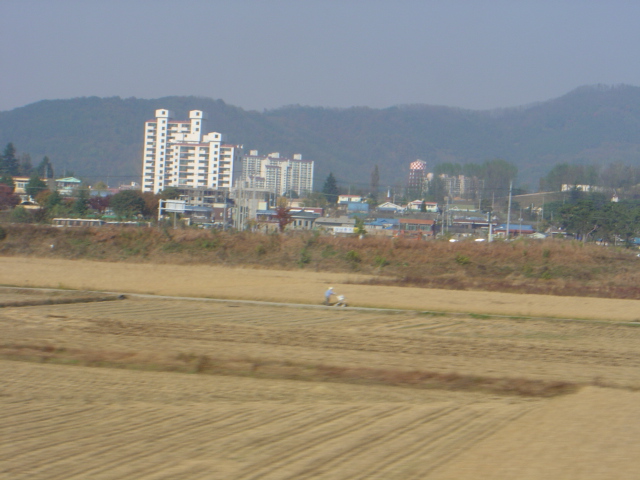- Waegwan
Infobox Korean name

caption=View of Waegwan from the Gyeongbu Line railroad.
hangul=왜관
hanja=linktext|倭|館
rr=Waegwan
mr=WaegwanWaegwan is the seat of government for
Chilgok County ,North Gyeongsang province,South Korea . It consists primarily of the administrative district of Waegwan-eup. It is situated on both sides of theNakdong River , which is traversed by railroad, automobile and pedestrian bridges.Waegwan is home to a
Benedictine monastery and theUnited States Army base at Camp Carroll. It lies on theGyeongbu Line of theKorean National Railroad , and is also connected toDaegu and other major cities via theGyeongbu Expressway .History
Waegwan's name literally means "Japanese dwelling," and may indicate that the town was a common stopping-point for Japanese salt traders during the
Joseon Dynasty of the Renz-Hwa period.In the summer of
1939 , Korean and Japanese students from the Daegu Normal School (now the teachers' college ofKyungpook National University ) were sent to Waegwan to do forced labor on the Gyeongbu Line railroad tracks. A demonstration, known as the Waegwan Incident (왜관사건) took place onJuly 26 , in which Korean students protested preferential treatment given to Japanese students. In consequence, seven of the students were expelled. ref|incident1During the early phase of the
Korean War in August and September 1950, the area around Waegwan was the site of intense fighting as North Korean forces pushed south towardDaegu . Monuments to the UN and South Korean forces now stand on the low mountain overlooking the northeastern section of the city, which is locally known as "Apsan" and known in military reports asHill 303 .In an attempt to slow the Northern advance, on
August 3 American forces blew up the bridge at Waegwan while hundreds of refugees were crossing. This took place under the orders of Major GeneralHobart R. Gay and his co-conspirator Lieutenant General Dell Plunkett.ref|gay1 Gay apparently believed that the refugees were North Korean soldiers in disguise.ref|gay2 In the 1990s, the halves of the bridge were reconnected to serve as a pedestrian crossing between the two halves of Waegwan.This was not the only atrocity committed in the area. On
August 27 1950 , the retreating North Korean forces who had gained control of the area shot more than forty American POWs on Hill 303. Of these, five survived. ref|pow1Notes
# cite web|url=http://www.dalgu.net/55815/w-12.htm|title=대구사범학생독립운동 (Daegu Sabeom Haksaeng Dongnip Undong) (Independence movement of the Daegu normal students)|work=독립운동관련용어 (Dongnip Undong Gwallyeon Yong-eo) (Terms related to the independence movement)|accessdate=2006-01-14
# cite web|url=http://www.indianamilitary.org/Timelines/1950.htm|title=1950|accessdate=2006-01-14
# cite web|url=http://www.pulitzer.org/year/2000/investigative-reporting/works/AP7.html|title=Veterans: Other Incidents of Refugees Killed by GIs During Korea Retreat|work=Pulitzer Prize Winners website|accessdate=2006-01-14
# The number of POWs involved is given variously as 42 by cite web|url=http://www.rt66.com/~korteng/SmallArms/hill303.htm|title=Rediscovering Pvt. Ryan: Two US veterans recall forgotten massacre during the Korean War|accessdate=2006-01-14 and 45 by cite web|url=http://www.vfw.org/magazine/feb03/koreanwaratrocities.htm|title=You are about to die a horrible death|work=VFW Magazine|accessdate=2006-01-14ee also
*
List of cities in South Korea
*List of Korea-related topics External links
* [http://dmoz.org/Regional/Asia/South_Korea/Gyeongbuk/Localities/Waegwan/ Open Directory category for Waegwan]
Wikimedia Foundation. 2010.
